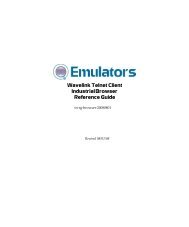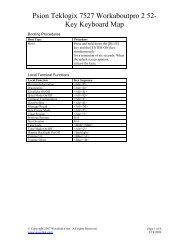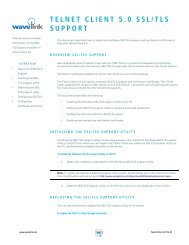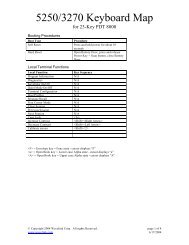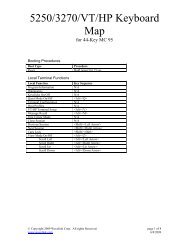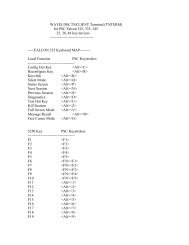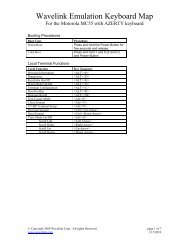Avalanche User Guide - Wavelink
Avalanche User Guide - Wavelink
Avalanche User Guide - Wavelink
You also want an ePaper? Increase the reach of your titles
YUMPU automatically turns print PDFs into web optimized ePapers that Google loves.
Chapter 1: Introduction 3• Databases. <strong>Avalanche</strong> databases store information about your network and devices. Thereare two databases for <strong>Avalanche</strong>. The Enterprise Server database handles information suchas managing device configuration. The Statistics Server database manages statisticalinformation regarding the state of devices on your network.NOTE: <strong>Avalanche</strong>-supported databases use Windows-1252 character encoding. If you try touse double-byte characters or other characters that are not listed on this code page (forexample, as the name of a location or profile), errors will occur and <strong>Avalanche</strong> will not savethe information.• Mobile Device Server. The mobile device server is responsible for communication betweenthe <strong>Avalanche</strong> Console and mobile devices. It distributes licenses and profiles and reportsdevice statistics.• Enablers. Mobile devices must have an <strong>Avalanche</strong> Enabler installed in order to be managedby <strong>Avalanche</strong>. An Enabler relays information between the mobile device and the MobileDevice Server. With the Enabler installed, the mobile device can receive configurationinstructions that you create in the <strong>Avalanche</strong> Console.In <strong>Avalanche</strong> SE, the servers and databases are all installed on the same system. The WebConsole and Java Console can be used local or remote from the enterprise server, but the JavaConsole must be installed at each location where it will be used.<strong>Avalanche</strong> SE installs one mobile device server (at My Location). You can subdivide MyLocation into group locations, which are groups of mobile devices. When a configuration isapplied at a location (either My Location or group locations), the devices included in thatlocation will receive that profile.Getting StartedFor best results in managing your <strong>Avalanche</strong> installation and configuration, <strong>Wavelink</strong>recommends performing the following steps in order:1 Install <strong>Avalanche</strong>. For more information, see the Installing <strong>Avalanche</strong> paper on the<strong>Wavelink</strong> Web site.2 Activate Mobile Device licenses for <strong>Avalanche</strong>. You should activate the number oflicenses based on the number of devices you want to manage. For more information, seeLicensing on page 6.3 Create group locations. Group locations are user-defined groups of devices that connect tothe. For more information, see Managing Group Locations on page 47.4 Configure profiles. A profile allows you to manage configurations and settings centrallyand then deploy those configurations to as many locations as necessary. In this way, you




